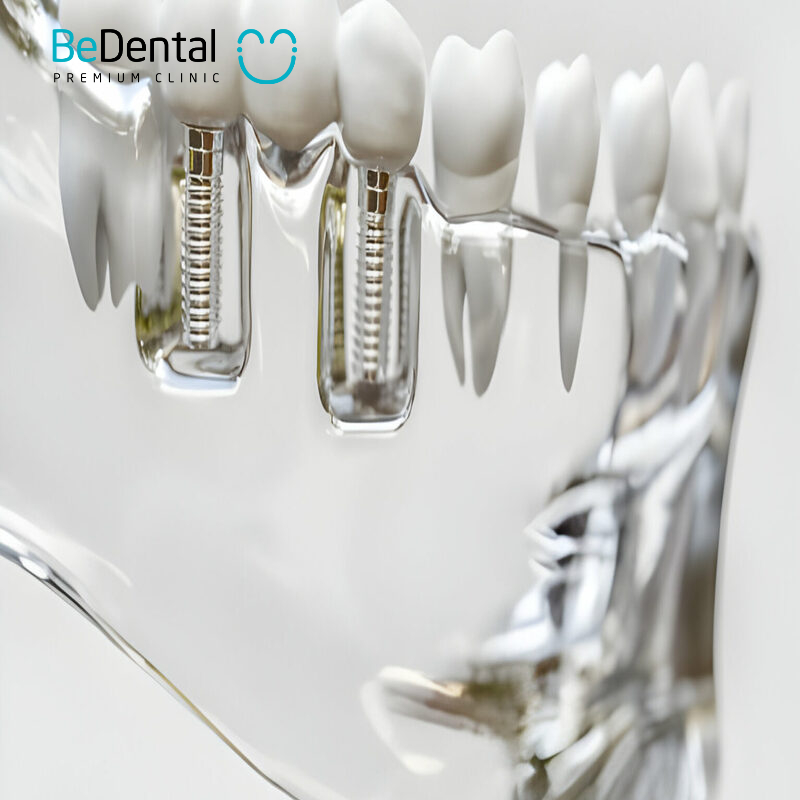Dental implants in HCM is a modern method for restoring lost teeth by placing a titanium or zirconia post into the jawbone, replacing the natural tooth root. This procedure is conducted in several stages, including examination, implant placement, and crown fitting. Statistics show that the success rate of dental implants can be as high as 95%. They not only improve chewing function and aesthetics but also preserve jawbone structure, offering durability and confidence for patients.
What are Teeth Implants?
What are dental implants? Dental implants in HCM city are a technique for replacing lost teeth by inserting a metal post (usually made of titanium) into the jawbone to serve as a foundation for a crown, bridge, or denture. The goal of dental implants is to restore chewing function, aesthetics, and to help protect the jawbone structure, preventing bone deterioration when teeth are lost.
Types of Dental Implants in HCM
There are various types of dental implants in HCM depending on the material and design:
- Titanium Implants (Titanium Dental Implants): The most common type, made from titanium, a metal known for its high biocompatibility with the human body. Titanium implants provide superior durability and integrate well with the jawbone, helping restore both chewing function and aesthetics. However, their metallic color may be less aesthetically pleasing in the front tooth area.
- Zirconia Implants: A metal-free alternative, zirconia implants are white and closely resemble natural teeth, offering greater aesthetic appeal, particularly for front teeth. They also have good biocompatibility and are less prone to bacterial colonization. However, zirconia is more brittle than titanium and is more susceptible to cracking, and the costs are typically higher.

- Mini Implants: Smaller than traditional implants, mini implants are often used in cases where the jawbone is not thick enough or to support dentures. Their placement is less invasive, resulting in shorter recovery times and lower costs. However, mini implants have lower durability and load-bearing capacity, making them unsuitable for high-stress areas.
- Endosteal Implants: The most common type of implant, endosteal implants are placed directly into the jawbone and are used in most cases of tooth loss. They integrate well with the bone, providing stable and long-lasting results. However, the placement process requires invasive surgery and longer recovery times.
- Subperiosteal Implants: These implants are placed on the surface of the jawbone, beneath the periosteum, and are typically used for patients with weak or thin jawbone structures that are not suitable for endosteal implants. Although recovery is quicker, this type of implant is less common and may be less stable than other types, with a higher risk of complications.
- Immediate Load Implants: These allow patients to have a new tooth immediately after placement without waiting for osseointegration. This offers convenience and reduces treatment time, but it is not suitable for all cases. Immediate load implants require the jawbone to be strong enough to support the new tooth and carry a higher risk of failure if integration is inadequate.
Who is a Good Candidate for Dental Implants in HCM?
Dental implants in HCM are suitable for most adults with good oral health and jawbone density (How to measure bone density of the jaw?). Those who have lost one or more teeth and wish to restore chewing function and improve aesthetics may consider this method. However, factors such as jawbone condition, overall health, and personal habits (like smoking and oral hygiene) can also affect the success of the implant.
The Dental Implant Procedure in Vietnam
How is tooth implant done in Hanoi and HCM? The steps of tooth implant in Vietnam usually is divided into three stages, each consisting of two steps:
Stage 1: Examination and Consultation
- Oral Health Examination: Before process of dental implants, the dentist will conduct a thorough examination of the patient’s oral health to ensure there are no issues like gum disease, tooth decay, or infections that could affect the surgery.
- Diagnosis and Treatment Planning: After a thorough evaluation, the dentist will take X-rays, create impressions, and assess the jawbone density. Based on these results, a specific implant plan will be developed, including the choice of implant type and the most suitable treatment approach for each case.

Stage 2: Dental Implant Surgery in HCM
- Placing the Implant Post into the Jawbone: The dental implant post in Vietnam is surgically inserted directly into the jawbone through a minor operation, conducted under local anesthesia or mild sedation. The tooth implant post will serve as an artificial tooth root to support the future crown.
- Recovery and Integration: After the implant is placed, it requires a healing period of 3 to 6 months for complete integration with the jawbone through a process known as osseointegration. During this time, patients must maintain proper oral hygiene and follow the dentist’s instructions to ensure implant stability.
Stage 3: Fitting the Prosthesis
- Designing and Fabricating the Crown: Once the implant has fully integrated with the jawbone, the dentist will take impressions to create a crown or bridge that fits the jaw structure. The crown is usually made from porcelain or composite materials to ensure aesthetics and function.
- Assembling and Adjusting: Finally, the prosthetic crown is attached to the implant post. The dentist will check the bite and make any necessary adjustments to ensure the prosthetic fits comfortably. The new tooth will function like a natural tooth, providing confidence and comfort for the patient during eating and speaking.
Benefits of Dental Implants
Dental implants offer significant advantages for patients, including:
- Improved Chewing Function: Implants restore chewing ability similar to natural teeth, allowing patients to eat comfortably without worrying about looseness or discomfort, unlike traditional dentures. This enhances digestion and helps maintain a healthier diet.
- Enhanced Aesthetics and Confidence: Dental implants provide a natural-looking replacement for missing teeth, contributing to a beautiful and balanced smile. Because implants are designed to match the shape and color of natural teeth, patients can smile confidently without fear of their dentures being visible or shifting.
- Preservation of Jawbone Structure: A critical benefit of dental implants is their ability to preserve the jawbone. When teeth are lost, the jawbone tends to shrink due to lack of stimulation from the tooth roots. Implants replace the natural tooth roots and stimulate bone growth, preventing bone loss and maintaining facial structure.
- Durability and Longevity: Compared to bridges or dentures, implants offer a longer lifespan when properly maintained. They are robust and do not wear down over time. With good oral hygiene and regular dental check-ups, implants can last a lifetime, providing sustainable and long-term effectiveness for patients.
Considerations for Dental Implants in HCM
Dental implants in HCM city are a modern and highly effective tooth restoration method. However, they are relatively more expensive than alternatives like bridges or dentures. The final cost varies depending on:
- The number of implants required.
- The type of implant used (e.g., Korean, American, Swiss, or Zirconia for aesthetics).
- Jawbone condition and whether additional procedures such as bone grafting or sinus lifts are necessary.
Patients should be aware that health insurance rarely covers dental implant costs. However, some premium dental insurance plans or financing options may provide partial coverage. Patients are encouraged to discuss payment plans and insurance details with their dentist.
| Implant Type | Price Range (USD) | Notes |
|---|---|---|
| Korean Implant | $630 – $1,050 | Popular, affordable, stable quality |
| American Implant | $1,050 – $1,470 | Advanced technology, good osseointegration |
| French Implant | $1,176 – $1,596 | High durability, fast integration |
| Swiss Implant | $1,470 – $2,100 | Premium quality, quick adaptability to bone |
| Japanese Implant | $1,260 – $1,680 | High-quality materials, quick integration |
| Aesthetic Zirconia Implant | $1,680 – $2,520 | White material, high aesthetics, suitable for front teeth |
| Implant Type | Vietnam (USD) | Europe (USD) | America (USD) |
|---|---|---|---|
| Korean Implant | $630 – $1,050 | $1,500 – $2,500 | $3,000 – $4,500 |
| American Implant | $1,050 – $1,470 | $2,500 – $3,500 | $4,000 – $5,000 |
| French Implant | $1,176 – $1,596 | $3,000 – $4,000 | $4,500 – $6,000 |
| Swiss Implant | $1,470 – $2,100 | $4,000 – $5,500 | $5,000 – $6,500 |
| Japanese Implant | $1,260 – $1,680 | $3,500 – $4,500 | $4,500 – $5,500 |
| Aesthetic Zirconia Implant | $1,680 – $2,520 | $5,000 – $7,000 | $6,000 – $8,500 |
Potential Complications and Risks
While the success rate of dental implants in HCM is very high, there are still some potential complications and risks. These can include infections at the implant site, nerve damage, and injury to nearby structures such as teeth or blood vessels. Additionally, the implant may fail to properly integrate with the jawbone, especially in individuals who smoke or have underlying health conditions like diabetes. Regular check-ups and following your dentist’s guidelines can significantly reduce these risks.

Post-Implant Care
Proper care after implant placement is crucial for long-term success. Patients should adhere to a soft food diet for the first few weeks to avoid putting too much pressure on the implant, while also maintaining good oral hygiene by brushing gently and using dental floss. Regular visits to the dentist are essential to monitor the implant’s condition and ensure proper bone integration, which helps maintain stability and prevent future complications.
Why is BeDental a trusted name for Dental Implants in HCM?
Dental implants in HCM offer an exceptional solution for replacing missing teeth, greatly enhancing chewing function, aesthetics, and long-term oral health. With a safe, meticulous procedure and a high success rate, this method is ideal for anyone looking to restore a confident and lasting smile. Additionally, proper post-operative care is vital to ensuring the long-term success of this treatment.
BeDental is a trusted name for dental implants in Vietnam due to its skilled specialists, use of high-quality materials, and modern technology. The clinic offers personalized implant solutions with a focus on long-term success and patient comfort, making it a top choice for reliable dental care.
For those seeking further consultation regarding dental examination services, please visit BeDental’s locations in Hanoi or Ho Chi Minh City. You can also reach us at our hotline: (+84) 934.61.9090 / (+84) 899.555.636 or through our Facebook page, BeDental, for prompt and accurate assistance.
Tư vấn chuyên môn bài viết:
BÁC SĨ DƯƠNG THỊ THÙY NGA
BEDENTAL - TOP STANDARD DENTISTRY SYSTEM
In HANOI
Address 1: 7B Thi Sach St, Ngo Thi Nham, Hai Ba Trung Dist, Ha Noi. - 0934.61.9090
Address 2: 343 Tay Son St, Nga Tu So Ward, Dong Da Dist, Ha Noi. (Nga Tu So Cross) - 0934.61.9090
Address 3: CC2 Tower Nguyen Huu Tho St, Dinh Cong Ward, Hoang Mai Dist, Ha Noi. (Inside True Hope ) - 0934.61.9090
In HO CHI MINH
Address 1: 53 -55 -57 Pho Duc Chinh St, Nguyen Thai Binh, Dist. 1, Ho Chi Minh. - 0766.00.8080
Address2: 25, City Land urban area, Go Vap Dist, Ho Chi Minh - 0766.00.8080
Working: 9am - 6pm everyday
Website: https://bedental.vn/en/





